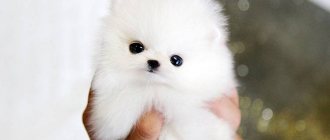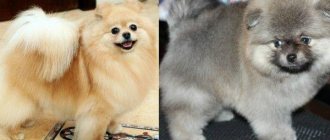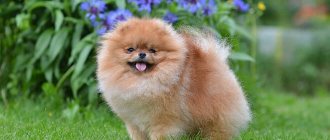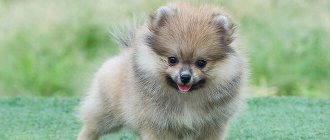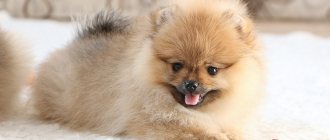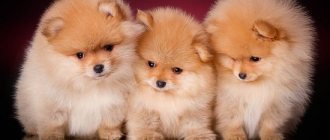Breed dossier
1. Country of origin: Germany.
2. Classification: Group 5. Northern sled dogs, Spitz and primitive. Section 4. European Spitz.
3. Training: needs early socialization. A smart dog, but can become stubborn and refuse to follow commands. This means that Mittelspitz was simply tired of monotonous repetitions. This dog perceives training as a game, and the game should be interesting.
4. Color: black, chocolate, red, gray, white. Any shades of these colors are acceptable. The color should be uniform, in harmony with the color of the eyes and nose.
5. Dimensions. Height at the withers: males: 32 - 35 cm, females 29 - 30 cm. Weight: 10 - 12 kg.
6. General impression: compact dog of harmonious build, fluffy and energetic.
7. Use: companion dog.
8. Physical activity: active. German Mittelspitz quickly get tired of monotonous training, but they love to play. The best pastime for these dogs is playing in the company of their beloved owner and his family. It is strictly forbidden to limit this dog in games and walks, because without splashing out its energy in movement and play, the Mittelspitz becomes irritable and “vocal” - it barks a lot for no reason.
9. Character: active, independent. The German Medium Spitz is a smart and energetic dog, very attached to its owner, his family and the house in which he lives. A change of environment is very stressful for this dog. Mittelspitz requires a lot of attention, and undivided attention, because Mittelspitz is a jealous person and will not tolerate competition from anyone.
10. Maintenance: suitable for keeping both in an apartment and in a country house. When kept in a cramped city apartment, the Mittelspitz should be walked at least twice a day, the walks should be long and active. If you live in a country house, you should maintain the temperature regime: both hypothermia and overheating are harmful to the Mittelspitz.
11. Grooming: labor intensive. The Mittelspitz has beautiful thick fur, which only enhances the dog's appearance. Feature of the Mittelspitz: the guard hair of a representative of this breed is longer and stiffer than the undercoat, while the undercoat is soft and similar to fluff. To maintain this dog's lush coat in proper form, you should carefully comb the Mittelspitz with a comb with thick, long teeth. When bathing this dog, use only mild shampoo, followed by conditioner. This will help prevent drying, brittleness and hair loss.
12. Accommodation: average. This is a jealous dog; due to lack of attention to itself, it can take its anger out on other pets.
13. Diseases: representatives of this breed have excellent health.
14. Diet: specially selected for small breeds of dogs. The Mittelspitz happily eats both dry food and natural food in the form of porridge, boiled meat, vegetables, and cottage cheese.
15. Life expectancy: 12 – 15 years.
Photo: Medium German Spitz (Mittelspitz)
History of the breed
It is believed that the ancestors of modern Spitz dogs were prehistoric types of dogs - lake and peat dogs, the remains of which were found by archaeologists in Central Europe.
Most European breeds come from these animals.
The first mentions of fluffy, pointy-eared Spitzhond dogs with fox-like faces and fluffy curled tails are found in sources of the 15th century, but directed work with the breed began only in the 18th century.
If you want to look at other dogs that look like foxes, we recommend that you read the selection in the article
At first, dog breeders in Germany were involved in breeding; later, the British and Americans began breeding Spitz dogs, trying to develop a smaller breed.
As a result, the German Spitz breed has 5 species.
These are Wolfspitz (Keeshond), large, medium, small and dwarf ( Pomeranian , toy Spitz).
In the USA and Great Britain, the Keeshond and Pomeranian are independent breeds with separate standards.
The German Spitz is an intelligent dog that can easily learn several tricks and commands.
Character
The German Spitz is the closest relative of the Pomeranian. More precisely, this is one breed, the dogs just differ in size. The Pomeranian is the smallest member of the German Spitz group, with the Lesser Spitz being slightly larger.
The German Spitz is an ancient dog breed and is considered one of the oldest in Europe. Images of similar animals have been found on clay tablets and pottery that are approximately 2,500 years old.
The German Spitz was originally a working breed. Small dogs were convenient to keep as guards: they are loud, sensitive and eat little, unlike their larger relatives. But everything changed in the 18th century, when aristocrats paid attention to the breed. So the Spitz quickly spread throughout Europe, reaching Russia and even America.
The breed standard was adopted at the end of the 19th century almost simultaneously in Germany and the USA. The German Small Spitz is a proud, brave and very wayward dog. This is an energetic pet who often imagines himself as a big and scary dog. With poor upbringing, this character trait will be clearly expressed. Therefore, work with representatives of the breed, in particular socialization, should begin quite early.
The German Spitz is a charming companion dog. He cannot leave anyone indifferent. Just looking at this fluffy one improves your mood. Add to this a cheerful disposition and excellent mental abilities, and it immediately becomes clear: this dog will find a common language with everyone. The German Small Spitz is suitable for both elderly people and families with children.
Pets of this breed very quickly become attached to their owner. They do not tolerate long separation well, so such a dog is unlikely to find happiness with a person who spends most of his time at work.
German Spitz dogs are known for their patience. The perky pet is ready to play with the child all day long. The main thing is not to offend the dog or cause it pain.
A small Spitz will not mind being in the neighborhood with other animals if the owner shows that the dog has no competitors.
Subscribe to our newsletter and get a free veterinary consultation
Thanks for subscribing!
Caring for a German Spitz
If the dog is provided with good care and a balanced diet, it will live to at least 15, and possibly up to 20 years. Starting from 2 months, the pet is taught to walk in the fresh air for 15-20 minutes, gradually increasing the time.
The weak point of a Spitz is its teeth.
To avoid periodontal disease, you need to take care of them and your gums by regularly cleaning them with a special brush and paste.
The puppy should get used to brushing teeth, washing paws, water procedures and combing from an early age.
Combing
With systematic hair care, it does not exist in the house. For combing, use a special comb and brush. The first is needed to remove tangled balls of hair and thorns that have become attached during a walk.
The comb also helps to fluff up the hairs, giving the pet a special attractiveness.
The brush is used every day, combing the dog from the back/chest and moving forward: to speed up the manipulation, the hair is divided into strands.
The tail, starting from the base, is combed last. The undercoat requires brushing only during shedding.
A haircut
The coat of these dogs (especially Wolfspitz) does not have an unpleasant dog odor, and their haircut is done in such a way as not to spoil their appearance.
Close attention is paid to the processing of the ears. For safe trimming, take small nail scissors. Long hairs in the ears are plucked out.
To ensure that the tail retains its luxurious charm, the hair on it is not cut short. The tangled tangles on the paws are cut off, slightly trimming the rear and side areas.
Wash and pedicure
Overly scrupulous owners of German Spitz dogs are capable of tormenting their pets with daily bath procedures. In fact, the dog is washed if it is either really dirty.
After bathing, the wool is intensively dried with a towel, and then a stream of warm air from a hairdryer is directed onto it.
An important indicator of grooming is a neat pedicure, which is done once every 2 months: long nails are trimmed with a nail clipper, and finally polished with a nail file.
Feeding
A puppy is fed 3-4 times a day, an adult dog - 2 times a day. Food is given at the same time, making sure that the pet eats it without leaving a trace.
If there is food left in the bowl at the end of the meal, reduce the dosage. Licking the container serves as a signal to increase the single portion.
- Raw and cooked meat (lamb, beef, horse meat and poultry).
- Fermented milk products, including cottage cheese.
- Eggs.
Vitamins and mineral supplements are given after consultation with a veterinarian.
Toilet
If you don't have the opportunity to take your dog outside often, train him to use the litter box. Spitz are extremely clean and quickly understand what a tray is for.
The main thing is not to humiliate or scold the puppy. Let your kindness become the main means of his upbringing.
Breed conformation standards
Head
medium size, proportional to the body. From above it has a wedge-shaped shape, which tapers very strongly towards the nose.
Ears
triangular in shape, placed close to each other, not large in size.
Eyes
almond-shaped, set slightly askew. Their size is medium and their color is dark.
Neck
The neck is strong and wide at the base, of medium length with a slightly curved crest. Around the neck is a lush collar of thick wool.
Frame
distinguished by weakly defined withers; back – straight, short and strong; loin – wide; the deep chest in front is well developed; The Pomeranian's croup is short but wide.
Limbs
the front ones are set quite wide and have a straight shape. The hindquarters are also straight, but have developed muscles and are covered with thick hair up to the hocks.
Tail
of medium length has a characteristic high rise: from the base it is raised up and twisted into a ring (or double ring) and pressed to the back. The tail has abundant wool covering.
Wool
double, consisting of a fluffy dense undercoat and long straight hair located away from the body. The body is covered with long hair without waves, curls and tufts, and the head, ears, the front side of both pairs of front legs and paws are covered with short and dense hair, velvety to the touch.
Care and maintenance
General requirements apply to the care of German Spitz dogs. The charm of the dog is given by its thick and lush coat. It is easy to care for - just brush it once a week, trying not to damage the undercoat. More often during molting period.
You should wash it infrequently, as needed, due to the small amount of subcutaneous fat. Before bathing, the dog needs to be brushed. It is advisable to start a haircut by cutting off the tangles. This procedure is simple at home, but you can also seek the services of a professional groomer.
It is worth taking care of the condition of the patient’s teeth, ears and eyes. Buy a special toothpaste and brush to clean your pet's teeth and gums. Clean your eyes with warm boiled water. Ears, very carefully, with cotton swabs on the auricle.
The following products must be included in the dog’s diet: lean meat - from 20% per day of the dog’s weight. In no case should you give pointed beef, poultry or fish bones, to avoid injury to the dog’s esophagus and getting them stuck in the throat, which can be fatal. It is strictly forbidden to give food that is unusual for dogs - sausage, smoked meats, flour products and sweets. The best cereals to eat are buckwheat and rice. It is advisable to combine dry food with natural products.
You can accustom a small Spitz to walks outside from 2 months, starting from 15-20 minutes, gradually increasing the time.
